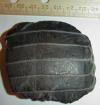Click the thumbnails for more information.
|
Beautiful Ray Plate
Craven County, North Carolina, USA - Unidentified - Ray |
|
|

|
This is the best ray plate I found. ... |
|
|
|
Ray "Poison Sack"
North Carolina, USA - Unidentified - Ray |
|
|

|
Here's another jumbo ray fossil. I'd love to know how big these rays were. ... |
|
|
|
Ray "Poison Sack"
North Carolina, USA - Unidentified - Ray |
|
|

|
This is a huge example of what people call a "poison sack" from a jumbo ray. I found this in N. Carolina. ... |
|
|
|
Ray Plate
Dorchester County, South Carolina, USA - Unidentified - Ray |
|
|

|
I had stopped to take a ground shot of a broken Angy sticking out of some fallen formation. When I turned around to put my camera back into my bag, I found myself face-to-face with one of the finds of the day. ... |
|
|
|
3/4" Ray Scute
Monmouth County, New Jersey, USA - Unidentified - Ray |
|
|

|
This is the first one of these I had ever found. Oddly, M4 found an identical one that was slightly smaller, just downstream from this one.... |
|
|
|
Ray Spine Tail Bone
Dorchester County, South Carolina, USA - Unidentified - Ray |
|
|

|
This is the bone in a stingray's tail against which the spine rests.... |
|
|
|
3" ray plate
Colleton County, South Carolina, USA - Unidentified - Ray |
|
|

|
A complete plate, but something wierd was going on there with the erosion. Could have been a bunch of clams, or maybe a cavity??... |
|
|
|
Stingray Tooth plate
Berkeley County, South Carolina, USA - Unidentified - Ray |
|
|

|
This is a Sting Ray Tooth Plate. Sting Rays are close relatives of Sharks, but they have a whole different routine when it comes to eating. They feast mainly on crabs and shellfish, so instead of ripping and tearing when they eat, they crush their prey against these hard plates. These are usually broken in strips, so I only have a few of these. It has a remarkable texture to the touch.... |
|
|
|